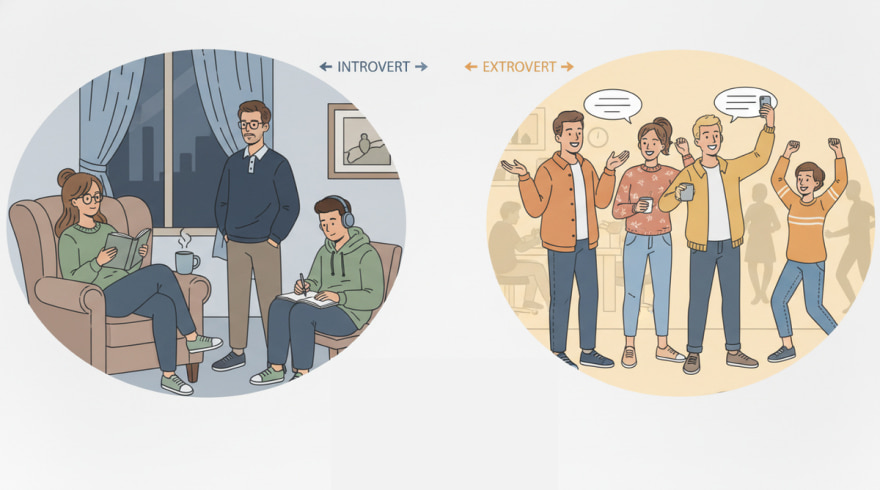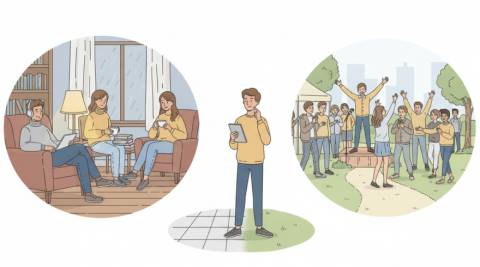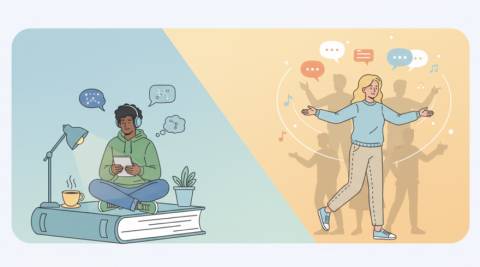Introvert Vs Extrovert: A Complete Guide to the Social Energy Spectrum and Its Benefits

What the Spectrum Really Means
Personality is best understood as a fluid spectrum of energy, attention, and social needs rather than a rigid label. In everyday conversations, the expression introvert vs extrovert meaning helps clarify how stimulation preferences influence mood and motivation. Instead of pigeonholing people, this lens offers a language for how we recharge, how we focus, and how we like to spend time. The result is a more compassionate view of coworkers, friends, and family who simply thrive in different environments. Framing everyday differences as extroverts vs. introverts can also guide expectations in social and work settings.
Researchers emphasize that no one is one hundred percent quiet or outgoing across every situation. In scientific literature, discussions of introversion vs extraversion describe a continuum shaped by temperament, habits, and context. You may favor solitude for deep work yet enjoy animated dinners with close friends, or crave bustling offices while preferring reflective planning in the early morning. These patterns shift with sleep, stress, culture, and life stage, which is why flexibility beats stereotyping.
- Energy source: some refuel through solitude and focus, others through social variety and novelty.
- Attention style: some prefer depth and fewer inputs, others prefer breadth and frequent interaction.
- Social appetite: some like long, meaningful exchanges, others like quick collaborative rhythms.
- Context matters: roles, norms, and goals can amplify or soften each tendency.
Understanding the spectrum delivers tangible benefits for relationships, learning, career growth, and wellbeing. It gives language to advocate for conditions that help you excel while respecting the needs of different styles. It also reframes differences as complementary strengths rather than incompatibilities.
The Science Behind Temperament and Social Energy
Modern personality science links preferred social intensity to underlying brain systems, learning history, and environmental demands. In trait research, scholars often examine extraversion vs introversion through reward pathways, arousal thresholds, and attention networks that tune how we seek stimulation. While biology sets a baseline, habit formation and skill-building can broaden your comfort zone. That’s why practice with public speaking, networking, or reflective writing can shift day-to-day behavior without changing core preferences.
Type frameworks can be helpful if used as conversation starters rather than destiny. Within type shorthand, many practitioners reference myers briggs i vs e to describe where people tend to direct energy, whether toward reflection or interaction. Used wisely, such labels highlight preferences for meeting formats, workspace setups, and recovery time after intense collaboration. Used carelessly, they harden into stereotypes and excuse avoidable communication gaps.
- Neuroscience suggests differences in dopamine sensitivity can influence novelty seeking and sociability.
- Attention control and sensory gating shape comfort with noise, multitasking, and rapid exchanges.
- Learned skills expand behavioral range, enabling calm focus or engaging presence as situations demand.
- Contextual fit remains critical; the same person can flourish or flounder depending on design and norms.
The takeaway is nuanced: your baseline is real, but your toolkit is expandable. With design and practice, anyone can collaborate productively while safeguarding their energy.
Communication, Relationships, and Daily Life
Everyday interactions reveal how pacing and preferences shape connection. In group conversations, the contrast of extroverts vs. introverts often shows up in pause length, turn-taking, and comfort with interruption. People who speak to think may prefer quick back-and-forth, while people who think to speak may want processing time before responding. Neither is inherently better; each rhythm fits different goals, from brainstorming to decision making.
Choosing channels thoughtfully reduces friction and boosts clarity. When planning collaboration, the framing of extrovert vs introvert can guide whether to lead with live dialogue or asynchronous notes before a meeting. Shared documents, pre-reads, and clear agendas help reflective participants prepare, while short stand-ups and whiteboard sessions energize those who ideate aloud. Blending methods creates psychological safety for both styles.
- Set expectations: define whether a session is for exploration, alignment, or commitment.
- Alternate formats: pair silent idea generation with fast-paced synthesis to include all voices.
- Protect pauses: invite written input and leave space after questions to avoid crowding quieter thinkers.
- Mind recovery: schedule breaks and offer follow-up channels for additional insights after meetings.
Relationships benefit when partners explicitly discuss social bandwidth, downtime, and preferred rituals. Simple agreements, like planning buffer time after events or rotating who hosts, can prevent misunderstandings and build trust.
Workplaces, Teams, and Leadership
High-performing teams design environments where diverse energy patterns are not only accepted but leveraged. Some facilitators invoke myers briggs introvert vs extrovert to spark reflection about meeting structures, workspace zoning, and focus sprints. The goal is not to label people but to tune the system: quiet nooks for deep work, lively areas for spontaneous collaboration, and norms that make both options accessible. When systems invite choice, productivity and morale rise together.
Hiring and role design also benefit from balanced thinking about strengths. In talent reviews, it helps when extrovert vs introvert vs ambivert is weighed against the core tasks, stakeholder needs, and decision horizons of the job. Customer-facing roles may prize quick rapport, while research-heavy roles may prize sustained concentration; many positions need both at different moments. Matching rhythm to responsibility transforms “fit” from a personality preference into a performance enabler.
- Meeting hygiene: publish agendas, define outcomes, and timebox segments for idea generation and critique.
- Physical and digital zones: blend quiet spaces, collaborative hubs, and asynchronous workflows.
- Feedback design: offer written feedback channels as well as live debriefs to diversify input.
- Leadership modeling: rotate facilitation and encourage preparation so varied voices shape decisions.
By normalizing different ways of contributing, organizations reduce bias, widen the talent pipeline, and build resilient cultures.
Ambiverts, Balance, and the Hidden Benefits
Most people display a flexible mix rather than a single mode, and that adaptability is a strategic advantage. In public discussions of mixed preferences, the phrase introvert vs extrovert vs ambivert positions versatility as a strength that toggles between depth and breadth. With awareness, you can dial engagement up or down to suit context, relationships, and desired outcomes. That capacity supports creativity, sales effectiveness, and conflict resolution.
Teams that appreciate complementary rhythms unlock compounding gains. In strategy cycles, a nuanced understanding of introvert vs extrovert can help leaders stage work so that solitary sense-making precedes collaborative synthesis. Early quiet exploration surfaces original angles, while later group sessions stress-test and refine the best ideas. The cadence improves decision quality without exhausting participants.
- Creativity: quiet incubation breeds novel connections, while active exchange pressure-tests feasibility.
- Wellbeing: respecting recharge needs lowers burnout risk and sustains performance over time.
- Inclusion: varied formats reduce dominance by a single style and increase psychological safety.
- Customer insight: alternating listening and dialog sharpens discovery and solution fit.
The practical benefit is agility: people and teams can meet moments with the right energy at the right time.
Self‑discovery Tools, Ethics, and Smarter Use of Assessments
Assessments can catalyze reflection when treated as mirrors, not verdicts. For those exploring their patterns, a structured introvert vs extrovert test may illuminate preferences for solitude, stimulation, and communication. The purpose is to spark hypotheses you can test in real contexts, not to box you in. Any result should be paired with observation, feedback, and iterative habit changes.
Short surveys are popular because they are quick and accessible. In lighter formats, a playful introvert vs extrovert quiz can introduce concepts before deeper exploration with validated instruments. After getting a snapshot, you can experiment with calendar design, meeting choices, and recovery rituals to see what measurably improves focus and satisfaction. Over time, data from your own work and wellbeing becomes the most authoritative guide.
| Tool | What It Offers | Best Use | Watch Outs |
|---|---|---|---|
| Validated trait inventories | Reliable scales for social energy, assertiveness, and activity level | Career development, team norms, longitudinal growth tracking | Requires interpretation; avoid treating scores as fixed limits |
| Short online questionnaires | Quick directional snapshots with low effort | Introductory learning, starting point for reflection | Variable quality; confirm insights with real-world experiments |
| 360 feedback and journaling | Behavioral evidence across contexts and stakeholders | Identifying strengths, blind spots, and situational patterns | Bias and noise; combine inputs and look for consistent themes |
Whatever tool you choose, treat results as a map, not the territory. The most ethical use of assessments is to expand choices, reduce friction, and tailor environments that let people contribute at their best.
FAQ: Answers to Common Questions
Are people purely one style or a mix across situations?
Most adults show a stable preference with meaningful flexibility. Context, stakes, energy level, and relationships can all shift behavior, so many individuals appear quiet in large groups yet animated in trusted circles, or vice versa.
Can someone change their baseline over time?
Core tendencies are relatively consistent, but skills and habits can broaden your range. With practice, people can become comfortable presenting, networking, or practicing solitude, even if those activities require more or less recovery afterward.
How can teams include different energy patterns in meetings?
Publish agendas, invite pre-work, and mix formats. Pair silent idea generation with live synthesis, solicit written input, and assign clear roles so both fast talkers and reflective thinkers influence outcomes without burnout.
What are signs that your environment doesn’t fit your rhythm?
Chronic exhaustion, irritability after routine interactions, difficulty focusing, or dread of recurring events often signal misfit. Tweaks like buffer time, quieter zones, or scheduled collaboration windows can restore balance.
Which habits support sustainable performance regardless of style?
Plan recovery proactively, protect deep work blocks, and set communication norms. Use boundaries around notifications, practice deliberate transitions between tasks, and experiment with social dosage that keeps energy steady across the week.
Bringing intention to energy management makes relationships richer, teams smarter, and work more humane. By valuing different rhythms, we build environments where everyone can contribute with clarity and confidence. That mindset bridges the everyday gaps often framed as extroverts vs. introverts.
Latest News



